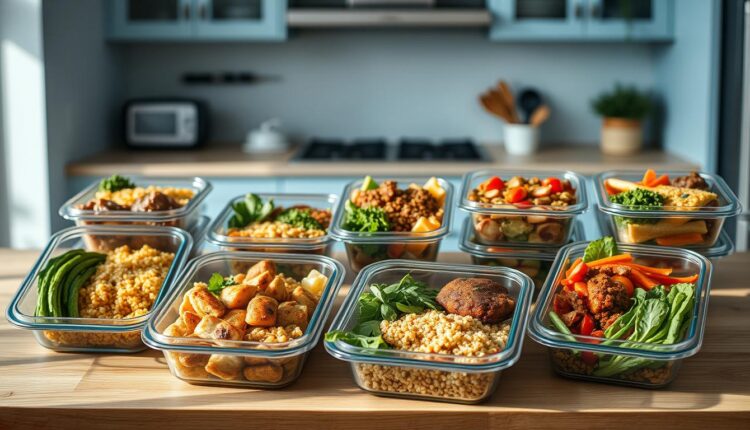High Protein Lunch Prep Weight Loss With Portion Control
Get started with high protein lunch prep weight loss! Explore our listicle for actionable meal prep tips, recipes, and strategies to support your weight loss journey
You’ve likely heard that planning your meals matters, but here’s the secret: how you structure those meals makes all the difference. As someone who’s juggled chaotic schedules and hungry families, I’ve found that focusing on intentional, protein-packed dishes—like tuna salad lettuce wraps or crustless veggie quiches—creates a rhythm that supports your goals without feeling restrictive.
Think of it as building a toolkit. When you prep-ahead with ingredients like grilled chicken, eggs, or fiber-rich veggies, you’re setting yourself up for success. These choices keep you fuller longer, curb afternoon cravings, and simplify decision-making during hectic days. Best part? You don’t need gourmet skills—just a little strategy.
Whether you’re packing lunches for work or feeding a family, this approach adapts. Let’s explore how to create meals that work as hard as you do—no perfection required.
Introduction: The Importance of High Protein Lunch Prep for Weight Loss
Let’s talk about building a solid foundation—one that keeps energy steady and cravings at bay. I’ve seen countless clients transform their habits by focusing on two pillars: intentional ingredient choices and smart preparation. It’s not about perfection—it’s about creating systems that work even on chaotic days.
Why Protein Matters
Protein isn’t just a buzzword. Studies show it helps regulate hunger hormones and preserves lean muscle during calorie deficits. For example, dishes like tuna salad wraps with Greek yogurt dressing deliver 15+ grams per serving. Dietitians often note:
“Aim for 20-30 grams per meal to optimize fullness and metabolic health.”
This approach prevents the afternoon slump many experience with carb-heavy lunches.
Streamlining Your Strategy
Planning meals isn’t about rigid schedules—it’s freedom. Batch-cooking versatile ingredients (think shredded chicken or roasted veggies) lets you mix-and-match flavors all week. Busy parents and professionals alike report:
- Fewer impulsive snack purchases
- More consistent energy levels
- Reduced decision fatigue
When you invest 90 minutes on Sunday prepping core components, you’re essentially creating a “nutrition safety net” for hectic days. Pair this with portioned containers, and you’ve got a recipe for lasting results.
Understanding Portion Control for Sustainable Weight Loss
Portion control might sound restrictive, but here’s the truth: it’s about balance, not deprivation. Think of it as a roadmap for enjoying your favorite dishes while staying aligned with your nutritional needs. When I first started meal planning for my family, I realized that eyeballing servings often led to overeating—even with healthy recipes.
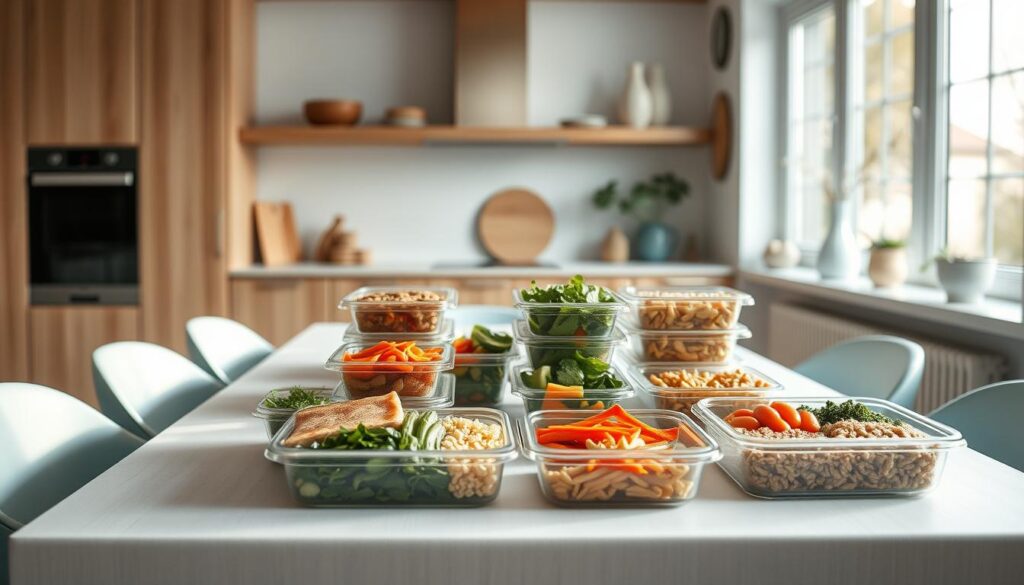
What is Portion Control?
Simply put, it’s understanding how much food your body actually requires. Unlike strict diets, this method focuses on awareness. For example, a single serving of rice is typically ½ cup cooked—about the size of a hockey puck. Using tools like food scales or pre-portioned containers removes guesswork and helps maintain calorie goals without constant tracking.
Tips for Measuring and Prepping Meals
In my kitchen, I’ve found these strategies work best:
- Use divided containers to separate proteins, grains, and veggies
- Prep snack-sized bags of nuts or chopped fruit in advance
- Batch-cook staples like shredded chicken (aim for 3-4 oz per meal)
| Food | Visual Guide | Grams |
|---|---|---|
| Grilled Chicken | Deck of Cards | 85-110g |
| Cooked Rice | Tennis Ball | 100g |
| Leafy Greens | Baseball | 30-50g |
Consistency matters more than perfection. Start by adjusting one meal at a time—maybe your afternoon salad or dinner protein. Over days, these small shifts become habits that support both your health and long-term goals.
Exploring Nutritional Benefits of High Protein Foods
Ever notice how certain meals leave you energized for hours? It’s not magic—it’s smart ingredient choices. As a chef juggling family meals and client menus, I’ve seen firsthand how prioritizing nutrient-rich foods transforms both energy levels and overall health.
Protein acts like your body’s repair crew. It rebuilds muscle fibers after activity and keeps your metabolism humming efficiently. Think beyond chicken breasts—foods like eggs, sharp cheddar, or even roasted chickpeas deliver this powerhouse nutrient while adding variety to your plate.
Colorful veggies play a supporting role. Broccoli packs vitamin C and fiber, while tomatoes add lycopene (a heart-healthy antioxidant). Pair them with Gruyère in a crustless quiche, and you’ve got a meal that satisfies hunger and nutritional needs.
Here’s my golden rule: combine textures and flavors. Try these pairings:
- Scrambled eggs with spinach and feta
- Grilled chicken over roasted broccoli
- Snap peas dipped in hummus
For meal ideas that balance taste and nutrition, explore our protein-packed recipe collection. Remember, great meals start with ingredients that work as hard as you do—no complicated techniques required.
Vibrant Meal Prep Ideas to Keep You Energized
Ever feel like your midday meal needs a burst of color and crunch? Let’s reimagine salads and sandwiches as flavor-packed fuel stations—dishes that excite your taste buds while delivering steady energy. These combos work whether you’re racing between meetings or need a quick fridge grab.
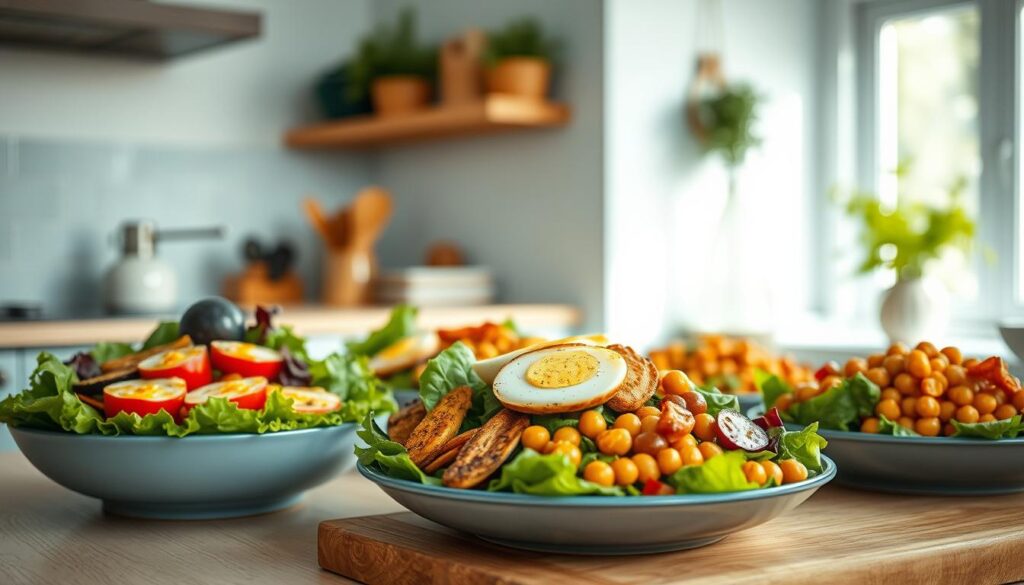
Creative Salad and Sandwich Combinations
Start with texture contrasts. Try shredded rotisserie chicken tossed with crisp romaine, cherry tomatoes, and a lemon-herb dressing. Layer it in a whole-grain wrap with avocado slices for creaminess. Prefer plant-based? Mash chickpeas with diced celery and dijon for a protein-rich sandwich spread.
Here’s my go-to formula for building meals that stay fresh:
| Base | Protein | Flavor Boost |
|---|---|---|
| Mixed greens | Hard-boiled eggs | Toasted almonds |
| Sourdough | Grilled turkey | Pickled onions |
| Quinoa | Black beans | Lime-cilantro dressing |
Customization is key. Swap dressings for variety—try tahini-lemon one day, balsamic glaze the next. For lower calories, use lettuce wraps instead of bread. Busy parents love these combos because they’re assembly-line friendly—prep components once, mix all week.
Keep it simple: colorful ingredients + bold flavors = meals you’ll actually crave. No fancy techniques needed—just a willingness to play with flavors. Your taste buds (and energy levels) will thank you.
high protein lunch prep weight loss: Strategies and Insights
Flavor doesn’t have to come with a calorie cost—it’s all about smart swaps and seasonal picks. Through years of testing recipes for picky eaters and health-focused clients, I’ve discovered fresh herbs and zesty citrus often outshine heavy sauces. The key? Treat your spice rack like a flavor toolbox.
Incorporating Fresh Ingredients
Vibrant, seasonal produce brings natural sweetness and texture. Try these simple upgrades:
- Swap mayo with Greek yogurt-based dressings (add dill + lemon for fish dishes)
- Toss roasted veggies with chopped basil or mint before serving
- Use ripe mango or pineapple chunks to balance spicy chicken wraps
Seasonal foods often pack more nutrients. A summer caprese salad with heirloom tomatoes and fresh mozzarella delivers creaminess without excess calories. In winter, roasted squash with sage adds earthy depth to grain bowls.
Maintaining Flavor Without Extra Calories
Spices are your secret weapon. Smoked paprika transforms plain turkey burgers, while cumin brightens lentil soups. Dietitian Sarah Ellis notes:
“Acidic elements like vinegar or citrus juice cut through richness, making dishes taste indulgent while keeping portions in check.”
Try these balancing acts:
| Ingredient | Low-Cal Boost | Pair With |
|---|---|---|
| Grilled Chicken | Chimichurri Sauce | Quinoa |
| Steamed Broccoli | Toasted Garlic | Lemon Zest |
| Hard-Boiled Eggs | Everything Bagel Seasoning | Avocado Slices |
Timing matters too—add delicate herbs like cilantro just before eating to preserve their punch. With these tweaks, your meals stay exciting and aligned with your health goals.
Chicken-Based Meals: Protein-Packed and Delicious
Let’s face it—chicken often gets labeled as “boring.” But in my kitchen, it’s a blank canvas for creativity. Whether I’m feeding teens who turn up their noses at “weird textures” or crafting meals for marathon-training clients, this lean staple adapts to any flavor profile or dietary need.
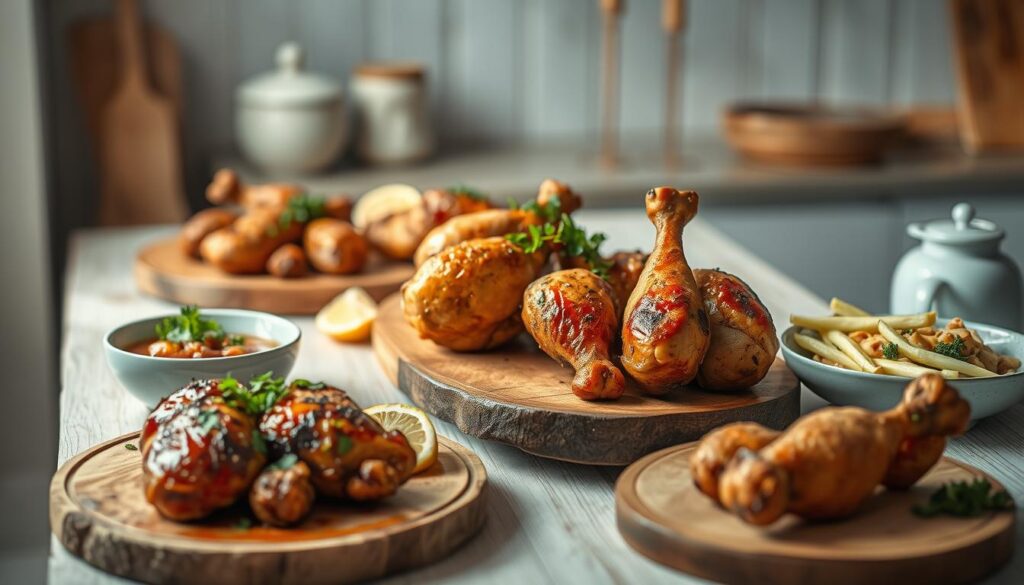
Reinventing Weeknight Classics
Rotisserie chicken becomes a hero ingredient when time’s tight. Shred it into a vibrant salad with crisp celery, toasted cashews, and a tangy lime dressing. Dietitian Maya Carter explains:
“Chicken’s amino acid profile supports muscle repair, making it ideal for active lifestyles. Pair it with crunchy veggies for satiety that lasts.”
Try these simple upgrades to basic dishes:
- Swap breadcrumbs with crushed almonds in baked tenders
- Mix ground chicken with grated zucchini for juicy burgers
- Toss shredded meat with Greek yogurt and dill for a protein-rich wrap filling
Marinating is key to keeping cuts moist. My go-to blend: olive oil, smoked paprika, and apple cider vinegar. Let breasts soak for 30 minutes before grilling—they’ll stay tender even when reheated.
| Seasoning Blend | Use Case | Prep Time |
|---|---|---|
| Lemon-Pepper | Sheet Pan Dinners | 10 mins |
| Curry Powder | Meal Prep Bowls | 5 mins |
| Herbes de Provence | Slow-Cooker Dishes | 2 mins |
For families, I batch-cook two versions of the same base—maybe teriyaki for adults and mild honey-mustard for kids. It’s all about working smarter, not harder.
Seafood Delights: Salmon and More for Protein Boost
There’s something special about adding seafood to your weekly rotation—it’s like unlocking a new level of flavor and nutrition. Salmon shines here, packing 22 grams of protein per 3-ounce serving alongside heart-healthy omega-3s. I’ve watched clients rediscover energy and satisfaction by swapping one poultry-based meal for a seafood option each week.
My go-to? Pan-seared salmon with crushed pink peppercorns. It’s faster than you’d think:
- Pat fillets dry, season with peppercorns and sea salt
- Sear skin-side down in olive oil (3-4 minutes)
- Flip, cook 2 minutes more—perfectly tender every time
Pair it with jasmine rice and steamed greens for a balanced plate. The rice absorbs the salmon’s natural oils, while veggies add crunch. Need inspiration? Our anti-inflammatory meal strategies pair beautifully with seafood-based dishes.
Batch-cooking tip: Cook multiple fillets at once. Store extras in airtight containers with lemon slices to maintain freshness. Reheat gently to preserve texture—30 seconds in the microwave at 50% power works wonders.
Seafood doesn’t have to be complicated or pricey. Frozen salmon works just as well for meal prep, and canned options make excellent salad toppers. Rotate different types (cod, shrimp) to keep your taste buds engaged while supporting overall health through varied nutrients.
Vegetarian and Vegan Protein Alternatives
Let’s bust a myth: plant-based eating doesn’t mean settling for bland salads. Some of my most satisfying dishes come from ingredients like chickpeas and lentils—foods that pack serious flavor while keeping you fueled for hours. Whether you’re vegan or just exploring meatless Mondays, these options deliver the nutritional punch your body craves.
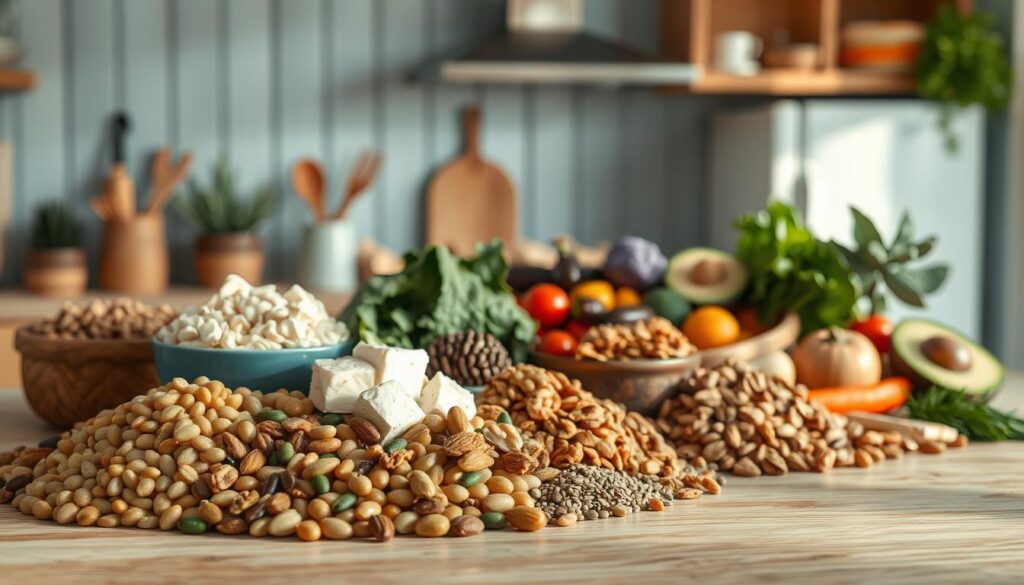
Chickpeas, Lentils, and More
Chickpeas are my weeknight MVP. Roast them with smoked paprika for crunchy snacks, or mash them into a creamy sandwich spread. One cup delivers 15 grams of protein and 12 grams of fiber—ideal for sustained energy. Dietitian Lara Fields notes:
“Legumes like lentils stabilize blood sugar better than many animal proteins. They’re a secret weapon for managing hunger during calorie deficits.”
Try these combos:
- Lentil taco “meat” with diced avocado
- Chickpea curry over jasmine rice
- Roasted red pepper hummus with veggie sticks
Tofu and Plant-Based Options
Tofu gets a bad rap, but it’s all about preparation. Press firm tofu, marinate in soy-ginger sauce, then air-fry for crispy texture. Pair with sautéed greens for a complete meal. For quicker options, try tempeh crumbles in chili or edamame in grain bowls.
Need inspiration? Our plant-based meal prep ideas turn these ingredients into crave-worthy dishes. Remember: balanced plates combine proteins, healthy fats (like avocado), and complex carbs. Your taste buds—and energy levels—won’t miss a thing.
Quick and Easy Meal Prep Recipes for Busy Days
We’ve all had those weeks where time feels scarce—but nourishment shouldn’t take a backseat. As a parent balancing soccer practices and client deadlines, I’ve perfected recipes that assemble in minutes while delivering lasting energy. The trick? Focus on modular ingredients that multitask across meals.
Grab-and-Go Recipes for Lunch and Dinner
Start with these no-fuss options:
- Cashew Chicken Stir-Fry: Toss pre-chopped veggies with rotisserie chicken and a 5-minute peanut sauce. Divide into containers with brown rice.
- Chickpea Salad Jars: Layer hummus, cherry tomatoes, and spinach in mason jars. Add drained chickpeas (15 grams protein per cup) and shake before eating.
- Breakfast-for-Dinner Wraps: Scramble eggs with diced peppers, then roll in whole-grain tortillas. Freeze extras for hectic mornings.
| Recipe | Prep Time | Protein Source | Storage |
|---|---|---|---|
| Vegan Buddha Bowls | 20 mins | Lentils + Tahini | 3 days fridge |
| Turkey-Stuffed Peppers | 25 mins | Ground Turkey | 4 days fridge |
| Greek Yogurt Parfaits | 5 mins | Greek Yogurt | 2 days fridge |
These dishes shine because they’re built for repetition without monotony. As I tell my cooking class students: “Batch-cook one base ingredient—like quinoa or roasted sweet potatoes—and let mix-ins keep things exciting.”
Store meals in portioned containers to streamline mornings. Need variety? Swap dressings or herbs each day. You’ll spend less time deciding what to eat and more enjoying meals that fuel your busiest days.
Tools and Containers: Making Portion Control Simple
Picture this: opening your fridge to find meals that look as good as they taste, with every ingredient in its place. The right tools turn chaotic meal planning into a streamlined system—no guesswork required. After years of testing containers that leaked, warped, or turned salads soggy, I’ve learned what truly works.
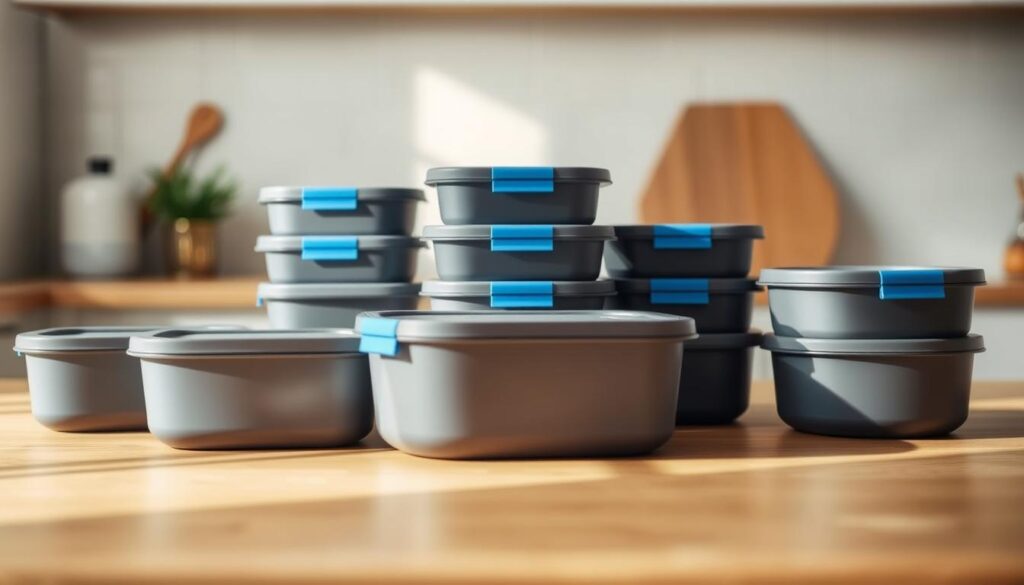
Choosing Containers That Work For You
Look for three features: durability, compartments, and stackability. Glass containers with silicone lids withstand daily use, while BPA-free plastic options are lighter for on-the-go days. Divided sections keep crispy veggies separate from dressings, preventing sogginess. As one client shared:
“Switching to bento-style boxes helped me visualize balanced portions—no more overfilling my plate.”
Here’s how I organize common dishes:
- Salads: Base greens in the largest compartment, toppings (like hard-boiled eggs or shredded cheese) in smaller ones
- Quiches: Individual silicone cups for crustless varieties, paired with roasted broccoli in a side section
- Stir-fries: Sauces in tiny leak-proof containers to add before reheating
Invest in tools that grow with your routine. A quality scale ($20-$40 range) and 1-cup portion scoops simplify measuring staples like quinoa or nuts. For families, color-coded lids help identify meals quickly during hectic mornings.
Remember: Your tools should make your life easier—not replicate someone else’s Instagram feed. Start with 3-5 versatile containers and build from there. Consistency comes from systems that fit your reality, not perfection.
Nutrient Timing: Fueling Muscle Recovery and Weight Loss
Timing isn’t just for athletes—it’s your kitchen’s secret weapon. When you eat matters as much as what you eat. Strategic nutrient timing helps rebuild muscles, stabilize energy, and prevent late-day crashes. Think of it as syncing your meals with your body’s natural repair cycles.
Optimal Meal Intervals
Research shows spacing meals 3-4 hours apart maintains steady blood sugar. Dietitian Maya Patel explains:
“Consuming 20-30 grams of protein within two hours post-workout maximizes muscle synthesis. Pair it with complex carbs to replenish glycogen stores.”
For example:
| Activity | Meal Timing | Key Ingredients |
|---|---|---|
| Morning Yoga | Breakfast within 1 hour | Eggs + Oats |
| Lunchtime Walk | Snack 2 hours later | Greek Yogurt + Berries |
| Evening Weights | Dinner within 90 minutes | Salmon + Quinoa |
Busy schedules? Prep protein-rich snacks like hard-boiled eggs or turkey roll-ups. These bridge gaps between meals without derailing progress. Consistency beats perfection—even small adjustments create lasting results.
Efficient Weekly Meal Planning and Preparation
Imagine opening your fridge to find organized containers of roasted sweet potatoes, seasoned ground turkey, and pre-chopped rainbow veggies—all ready to assemble. This isn’t a fantasy; it’s what happens when you treat meal planning like a strategic game. My Sunday reset routine (coffee in hand, podcast playing) transformed chaotic weeks into smooth sailing. Here’s how to make it work for you.
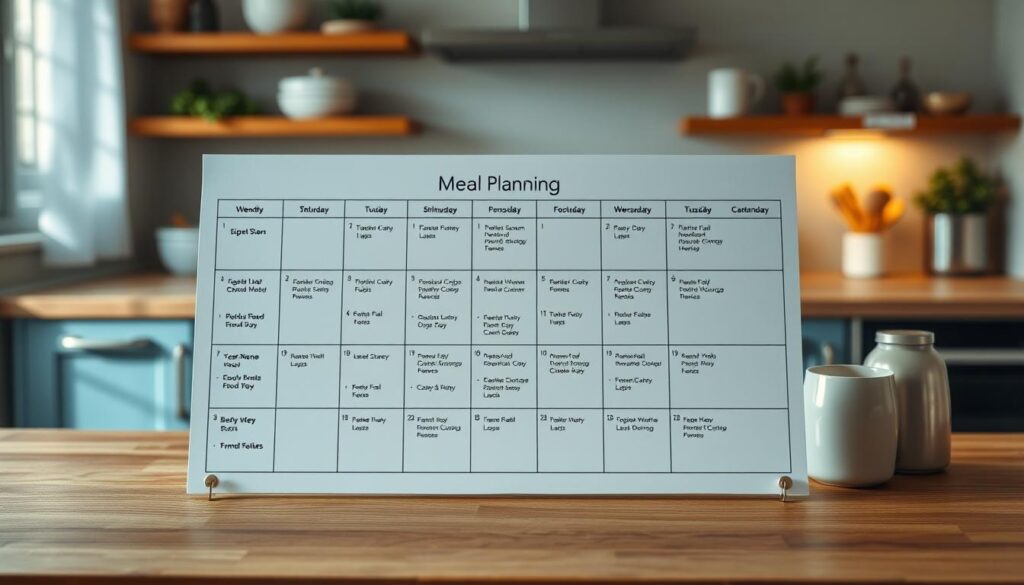
Building Your Blueprint
Start with a 20-minute brainstorming session. Check pantry staples, then pick 3-4 core recipes sharing ingredients. For example, taco-seasoned chicken works in salads, wraps, or grain bowls. Dietitian Jenna Miller advises:
“Design meals around overlapping components—like roasted veggies used in both stir-fries and omelets. It cuts shopping time and reduces waste.”
My go-to weekly framework:
- Monday/Wednesday: Grill double protein portions
- Tuesday/Thursday: Repurpose leftovers into new dishes
- Friday: “Clean-out-the-fridge” bowls
Smart Grocery Hacks
Group your list by store sections—produce first, proteins last. This prevents backtracking and impulse buys. Busy parents love these tricks:
| Task | Time Saver | Example |
|---|---|---|
| Chopping | Use pre-cut veggies | Stir-fry kits |
| Cooking | Batch grains in rice cooker | 3 cups quinoa |
| Storing | Freeze sauces in ice cube trays | Pesto cubes |
Reserve two servings from each recipe for freezer meals. On exhausting days, just reheat and add fresh greens. Your future self will thank you.
Creative Modifications to Fit Your Calorie Goals
What if your favorite dishes could adapt to your needs? Calorie-conscious cooking isn’t about restriction—it’s about smart swaps that keep flavors bold. I’ve helped clients trim hundreds of calories from meals simply by reimagining ingredients they already love.
Start with one simple rule: upgrade, don’t eliminate. Swap mayo in chicken salad with mashed avocado (cuts 80 calories per serving) or use egg whites instead of whole eggs in breakfast wraps. These tweaks preserve creaminess and protein while aligning with your goals.
“Focus on what you can add—like extra veggies or spices—instead of fixating on cuts. Satisfaction drives long-term success.”
Try these adjustments for popular dishes:
| Recipe | Original | Modified | Calorie Savings |
|---|---|---|---|
| Turkey Sandwich | White bread + mayo | Whole-grain + hummus | 110 |
| Pasta Salad | Regular noodles | Zucchini noodles (50%) | 160 |
| Stir-Fry | Vegetable oil | Broth sauté | 90 |
Portion control plays a role too. Serve meals on smaller plates, or bulk up dishes with roasted mushrooms instead of rice. My family’s favorite? Using spiralized sweet potatoes as a base for chili—adds vitamins and cuts carbs by 40%.
Remember: minor changes create major impact. Roast veggies instead of frying them, or blend cottage cheese into sauces for extra creaminess. Your taste buds won’t notice the difference—but your progress will.
Expert Insights: Advice from Dietitians and Nutritionists
Let’s cut through the noise—what actually works for long-term success? Nutrition experts agree: sustainable habits trump quick fixes. Jennifer Blow, a registered dietitian, emphasizes:
“Meal planning should feel like a roadmap, not a rulebook. Focus on balance—combine lean proteins, complex carbs, and colorful produce to nourish your body and cravings.”
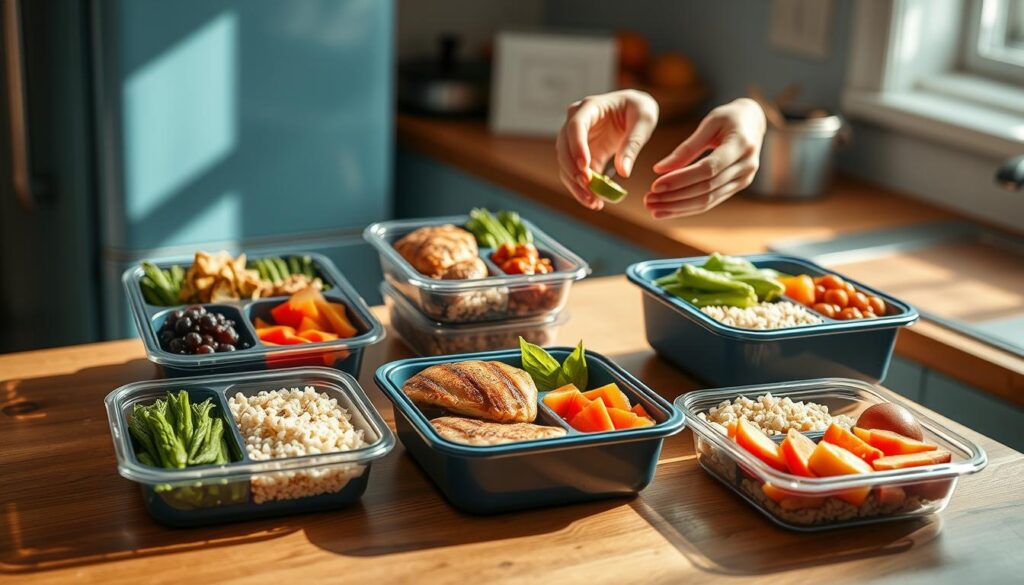
Science-Backed Kitchen Strategies
Research shows structured meal routines reduce impulsive eating by 34%. Here’s how to apply evidence-based methods:
- Pair 20-30 grams of protein with fiber-rich veggies (think spinach or bell peppers)
- Use hand-sized portions for intuitive serving control
- Prep dressings separately to maintain crisp textures
| Expert Tip | Science Basis | Action Step |
|---|---|---|
| Batch-cook proteins | Reduces decision fatigue | Grill 5 chicken breasts weekly |
| Add acidic elements | Enhances flavor perception | Keep lemon wedges handy |
| Freeze leftovers | Minimizes food waste | Label containers with dates |
Tailor these methods to your schedule. A parent might prep snack boxes with hard-boiled eggs and carrot sticks, while a busy professional could prioritize 15-minute assembly meals. As Blow notes, “Your plan should adapt to your life—not the other way around.”
Incorporating High Fiber for Added Fullness
What if your meals could keep you satisfied for hours without constant snacking? That’s the magic of pairing smart protein choices with fiber-rich ingredients. My friend Lisa—a nurse with back-to-back shifts—swears by this combo. “When I add roasted broccoli to my chicken bowls,” she says, “I don’t even think about snacks till dinner.”
Fiber works like a slow-release energy capsule. It helps stabilize blood sugar and keeps digestion steady. Chickpeas deliver 12 grams per cup, while broccoli offers 5 grams per serving. These aren’t just numbers—they’re tools for staying full between meals.
Here’s how to weave them into your routine without extra work:
- Toss a handful of spinach into scrambled eggs
- Mix cooked quinoa or brown rice into salads
- Swap croutons for roasted chickpeas in soups
| Ingredient | Fiber (grams) | Pair With |
|---|---|---|
| Black Beans | 15 | Grilled Chicken |
| Broccoli | 5 | Hard-Boiled Eggs |
| Pearl Barley | 6 | Roasted Veggies |
Combining these with your go-to protein sources creates meals that stick with you. Try a chickpea and egg scramble for breakfast, or layer shredded chicken over barley for lunch. The goal? Build satisfaction into every bite—no complicated recipes required.
Conclusion
Meal prep isn’t about rigid rules—it’s your kitchen’s invitation to freedom. By pairing intentional ingredients with portioned containers, you create a rhythm that supports your health without draining time or joy. I’ve seen clients transform chaotic days into nourishing routines simply by batch-cooking versatile staples like grilled chicken or roasted chickpeas.
Remember: nutrition thrives on simplicity. Those colorful salads and crustless quiches you prepped? They’re tools for steady energy and lasting satisfaction. Experts agree—structured meals with 20-30 grams of protein and fiber-rich veggies curb cravings better than restrictive diets ever could.
Your journey starts small. Swap one takeout order for a mason jar salad. Use divided containers to visualize balanced portions. Every meal is a chance to fuel your body and celebrate progress, not perfection.
Ready to own your week? Grab those containers, raid your spice drawer, and let your fridge do the heavy lifting. With these strategies, you’re not just prepping food—you’re crafting a lifestyle that bends to fit your busiest days.

